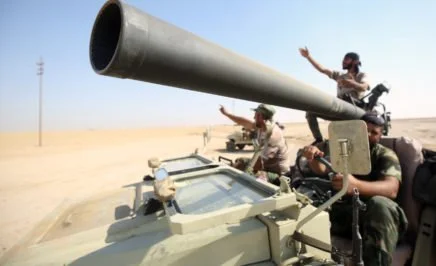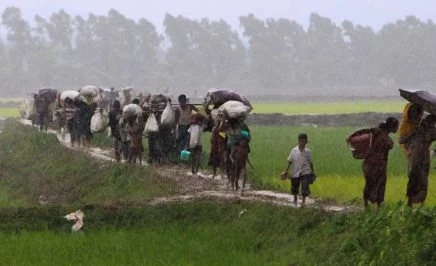- Amnesty team analysed satellite imagery, videos, photos and dozens of testimonies
- Lootings, arson and house demolition targeted predominantly Kurdish areas
- At least 11 civilians killed by indiscriminate attacks
- Tens of thousands now displaced afraid to go back home
Satellite images, videos, photos and dozens of testimonies collected by Amnesty International show that civilians were forced to flee their homes after fierce clashes erupted between Iraqi government forces, supported by the Popular Mobilisation Units, and Kurdish Peshmerga forces in Iraq’s multi-ethnic city of Tuz Khurmatu on 16 October 2017.
Residents reported that at least 11 civilians were killed by indiscriminate attacks, while hundreds of properties were looted, set on fire and destroyed in what appears to be a targeted attack on predominantly Kurdish areas of the city.
“Within hours the lives of countless men, women and children were devastated in Tuz Khurmatu. Thousands have lost their homes, shops and everything they owned. They are now scattered in nearby camps, villages and cities, wondering whether they will ever be able to return,” said Lynn Maalouf, Director of Research for the Middle East at Amnesty International.
“The Iraqi authorities already stated they would not tolerate any attacks against civilians, and would hold perpetrators accountable. They must now put word to action, and promptly initiate impartial investigations into these violations. Victims must receive full reparation and those responsible held to account.”
Between 18 and 23 October, Amnesty International interviewed 42 displaced residents of Tuz Khurmatu, conducted analysis of satellite imagery of the city and analysed and authenticated photos and videos provided by residents showing damage to homes and other civilian property caused by arson and looting.
Tuz Khurmatu residents told Amnesty International that heavy clashes broke out after midnight on 16 October. Most of the civilians interviewed reported that they fled the city between 2am and 6am as a result of the fighting. The United Nations Assistance Mission for Iraq (UNAMI) informed Amnesty International that nearly 35,000 civilians have fled Tuz Khurmatu since 16 October.
Burning, looting, and house demolitions
“I can’t describe what I saw. There is so much destruction – you can’t even imagine this was a city.” Zargos
Residents who are still in the city, as well as others who fled and then attempted to return, described how Iraqi government forces, as well members of the Popular Mobilization Units (PMU), Turkmen fighters and Turkmen civilians engaged in rampant arson, looting and demolition of civilian homes.
Witnesses reported receiving threatening messages or phone calls from their Turkmen neighbors. Those who had returned briefly to the city reported seeing extensive damage to homes in al-Jumhuriya and Hai Jamila, both Kurdish-majority neighbourhoods. Amnesty International authenticated photos and videos it received from witnesses showing the damage caused to civilian homes and property by looting and arson in Tuz Khumatu.
“Sangar” returned briefly to the city to check on his house. He told Amnesty International: “I was creeping through the city, trying to avoid seeing anyone…The market in al-Jumhuriya was completely burned out. And I saw some houses that had been exploded. They were completely collapsed. My house was burned, too…It looked like 90% of the buildings in al-Jumhuirya were burned.”
“I was creeping through the city, trying to avoid seeing anyone… The market in al-Jumhuriya was completely burned out. And I saw some houses that had been exploded. They were completely collapsed. My house was burned, too… It looked like 90% of the buildings in al-Jumhuirya were burned” – ‘Sangar’
“Hameed”, a 68-year-old man, told Amnesty International that on 19 October he travelled from Zinana, the village to which he had fled on 16 October, to Tuz Khurmatu to check on his house, which is located near Sitar Mosque in al-Jumhuriya neighbourhood. He described what he saw:
“When I got to my house, I saw that the door was broken, and the TV and the refrigerator were burned…When I went in, I realised my house was still on fire… We went to my son’s room, and it was like a pressure cooker inside. I fell over from the shock of the heat, and I almost fainted. My house was beautiful – it had two storeys. I loved that house. I kept trying to put out the fire, but finally my nephew said, ‘Uncle, we have to go – it’s not safe for us here’.”
According to “Sarhang”, who stayed in al-Jumhuriya neighbourhood until 6pm on 16 October: “More than 100 people on motorcycles were riding around the neighborhood… They knew the houses [and entered them] one by one. They took anything valuable or worth something. Then they set fire to a blanket and threw it into the house. The fire is [then] lit, and the whole house catches fire. They leave it to burn. I saw trucks and lorries [driven by] the PMU and Turkmen. The Turkmen are PMU anyway. They would take kitchen counters, fridges, stoves – whatever they can.”
Residents also mentioned the history of clashes and revenge attacks between Kurdish and Shi’a Turkmen residents of Tuz Khurmatu. In a chilling example of the tension between the two groups, “Sherine” a resident of al-Jumhuriya neighborhood told Amnesty International that on 15 October, her Turkmen neighbour saw her buying plates and pots in the market. She told her: “Keep buying. I want Kurds to buy things, because in the end it will be left behind for me.”
Indiscriminate attacks
Tuz Khurmatu residents reported that the weapons used in the densely populated city included mortars, RPGs, DShk heavy machine guns and Kalashnikov assault rifles. Civilians interviewed by Amnesty International were unable to determine whether the attacks they experienced were attributable to Kurdish or Iraqi government forces; however, in several of the cases documented by Amnesty International, the indiscriminate fire was launched into crowds of Kurdish residents fleeing the city.
According to “Sherine”:
“One [mortar] fell very close to our front door. It was about 2am and very dark. The children started screaming and I screamed too. I didn’t take anything. I’m still wearing the same dress as I wore that night. It’s so filthy, but what can I do? I don’t know how I managed to get the children into the car. Everyone was on the street. People were running and in their cars. It was so dusty. The mortars kept coming. We heard the Peshmerga were running away, and that really frightened us. We drove into the emptiness and didn’t stop until Qala Dawoodi [a village about 12km from Tuz Khurmatu]. We slept outdoors until dawn.”
“Sherine” told Amnesty International that there are no military installations near her house.
“Soran”, an 18-year-old man from Hai Jamila, told Amnesty International:
“A mortar fell near my house, and because of that, we fled. I was with my family. We are six people – my mother, father, my brother, two sisters and me. I saw at least a thousand people fleeing with us – it looked like a sea of people. We had to get through the irrigation project to get out. There are all of these ditches and small ponds we had to get through. The mortars were falling around us, and snipers were shooting at us. Some of the elderly people were left behind. Others were carried in blankets – we had to carry them so they didn’t fall in the water. I saw one man who was hit in the leg by a sniper’s bullet. He fell down, and I don’t know what happened to him. Another man was shot in the head and died instantly, in front of me.”
“There are all of these ditches and small ponds we had to get through. The mortars were falling around us, and snipers were shooting at us. Some of the elderly people were left behind. Others were carried in blankets” – ‘Soran’
“Soran” told Amnesty International that there were no military installations near his house and that the crowd fleeing was made up solely of civilians.
“Jamil” also fled Tuz Khurmatu with his family, around 3:30am on 16 October. He explained:
“We left on a tractor. It was all we had. We had to go out by a route that goes by the mountains and the irrigation system. It was really difficult – there were bullets whizzing by our head and mortars flying around us. We were so scared. I was with my wife and four children. When we left, I thought to myself: I will definitely lose my house to the burning and the looting, so now I need to take care of my family.”
“Jamil” told Amnesty International that there were no fighters near him during his flight outside the city.
Nowhere to Turn
Of the 42 civilians interviewed by Amnesty International who fled the city and are now sheltering in nearby villages, camps and cities, none felt safe enough to return to Tuz Khurmatu. Amnesty International spoke with four Tuz Khurmatu residents who had returned briefly to check on their homes or shops, but all had returned within hours, citing concerns for their safety. Tuz Khurmatu residents who had fled the city also consistently reported that none of their Kurdish neighbours have returned to the city permanently after 16 October or had any plans to do so.
“Abbas” told Amnesty International:
“I want you to know that for us as Kurds, we can’t go back to Tuz Khurmatu… At any moment they can come in a car and pick me up, for any reason… If I need to get a national ID or get some official documents, I would have to go to the intelligence. If I go there, I might never come back… They could kill me, or hold me hostage. We are afraid. And we are sure this is what will happen.”
“Othman” added: “I will never go back until we have guarantees for our safety. They even burn our mosques – how can we be safe there?”
“Residents of Tuz Khurmatu have suffered repeated cycles of violence in past years, and violations such as these lead to future cycles, unless the Iraqi government sends a strong signal – not only in word, but by way of concrete action – that perpetrators will be held to account, victims compensated and that the authorities will take all necessary steps to protect the displaced civilians,” said Lynn Maalouf.
“Humanitarian support for the tens of thousands of people who have fled Tuz Khurmatu must be earmarked and provided as a matter of urgency, both by the international community and the Iraqi government. It is also essential that the authorities swiftly restore security and the rule of law and establish conditions conducive to the safe, voluntary and sustainable return of tens of thousands of displaced residents.”
Background
Tuz Khurmatu was under the joint control of the Kurdistan Regional Government forces, the Population Mobilization Units (PMU) and local police, until Iraqi government forces supported by factions of the PMU took control of the city on 16 October. Its population of more than 100,000 is multi-ethnic, comprised of Kurds, Turkmen and Arabs. The city has been the site of sporadic clashes and communal violence since 2003.
The most recent clashes had occurred between October 2015 to January 2016, when Kurdish Peshmerga and members of Shia Turkmen militias killed, wounded and abducted civilians and destroyed hundreds of homes and shops.




